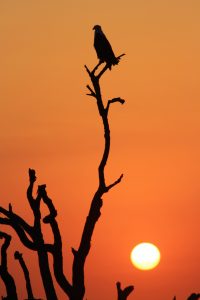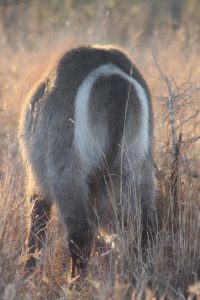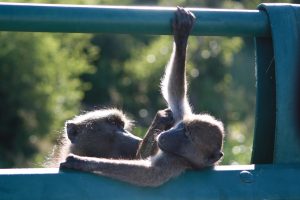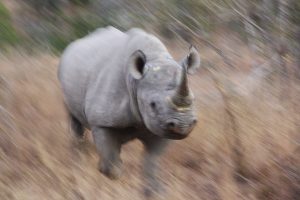Taking a contemplative approach to your safari photography
Posted in:Experiences | News
Posted on:March 14, 2017
There’s nothing quite like being out on an open game vehicle in the African bushveld, a red sun rising, camera ready and every sense alert at the thrill of what you might encounter. Here are some creative practical exercises that you can try while out on safari to adopt a more contemplative approach to your wildlife photography.

Still dawn – image by Jonathan Bertram
Exercise 1: Find Stillness

Poised – image by Berenice Meintjes
Many of us start out on safari with a greedy, grabby approach to ‘getting that shot’. Gently transition from that hectic pace of your usual life and let the rhythm of Africa work on your soul. You will feel the qualitative shift inside you and in the quality of your images as you become increasingly still and connected. Pause to become appreciative of the privilege of being outside under open skies.
Adopting a contemplative approach to wildlife photography can enhance your experience and sharpen your awareness to engage more deeply with your context. Here are some mindfulness strategies to assist you in finding this elusive stillness:
- Gradually slow down. Look more and take fewer snaps. On a walking safari or even at the coffee stops and back at the lodge – walk more slowly and be conscious of the movement of each step, rather than rushing about wildly. Stop to watch a praying mantis’ hesitant walk and copy the slow movement of a chameleon.
- Become aware of your senses and bring a full sensory experience into your photography – literally take time to smell the acacia, listen to the sounds of the bush, feel the breeze on your face.
- Breathe – if the situation allows, take a moment to take a deep breath and release it before you press down on your camera.

Oxpecker at dawn – image by Sharon Grussendorff
- Practise single-tasking, the simple act of doing one thing at a time, rather than chatting, taking a photo, plotting a witty caption and planning your next move all at the same time.
- Become fully attuned to this present moment, rather than constantly planning ahead or waiting for the time when things are exactly as you envisaged they would be.
- Tell your guide when you are ready to slow down – many safari guides feel pressure to rush about covering vast territory on one outing and may be relieved to hear that you are interested in slowing down and appreciating the little things and not just ticking off ‘the Big 5’. Most guides are genuine nature lovers who delight in introducing you to the lesser known and hidden beauties of their world.
- Literally stop and stay still in one place for a while – you will be amazed by what creatures shyly appear when you stay very still and quiet in one place.
Exercise 2: Follow the golden light

Hyena sibling puppies playing in the morning light – image by Berenice Meintjes
Much of visual art is about capturing that elusive phenomenon of light. A photograph of even a close sighting of big game may look flat if the lighting is dull, whereas a well-lit image pops out of the page or screen. Fortunately, most safari outings take place during the hours of golden light – the early hours of the day and the late afternoon or early evening, when animals are most active during the change of shifts between nocturnal, diurnal and crepuscular (active mainly at dawn and dusk) beasties.

We can’t get enough of these fluffy bums – image by Berenice Meintjes
Here are some practical steps to try out during this exercise of ‘following the golden light’:
- Become attuned to the quality of light – is it a cold, white breaking of day, a soft pink dawn, a warm, golden day or a rich red dusk?
- Catch what shimmers and let your eyes be drawn to different plays of light – a shine on an animal’s horn, a glow of light through an animal’s ear, a sliver of light lining the edge of the fur on an animal’s back, a reflection of an animal in a puddle or lake, slanting light highlighting the leathery texture of a thick skin or a silvery dewdrop-bejewelled spider’s web.
- Focus on capturing the essence of the quality of light, even forgetting about composition for a while as you hone this skill. Include a focus on light reflected on plants, earth and water in this practise.
- Capture silhouettes by turning off your flash and using a tripod or placing your camera somewhere still.
- If you are on a guided drive or walk, ask your guide where the best lighting may be found. They may know of spectacular sunset dams or sunrise crevices.
- Back at your lodge, practise low lighting settings by capturing the warmth of an open fire or bright light settings of the sun slanting across a deck or reflected in a pool.

Ragged – wild dog image by Berenice Meintjes
Exercise 3: Look for Interaction

Enough already – image by Berenice Meintjes
Spend time enjoying watching animals interact and try to capture some of these fascinating exchanges – a mother cuddling a baby, toddlers playing or teenagers fighting, siblings cleaning one another or a bird displaying it’s feathers to attract a mate.
- Once again, take time to observe animals – when one initially drives or walks near an animal they may have a startle response, and this fear may transfer unfavourably to your image. Whereas when you take time to be still and wait, animals often relax and quickly resume their natural interactions, even playing creatively with one another and objects in their environment.
- Be as quiet as possible – animals are sensitive to noise which may create interference in images. As you become still, the animals will relax more quickly and your own sensory perceptions will be enhanced.
- Look for what we perceive as ‘human-like’ interaction which can enhance the ‘story’ of your image.
- Or simply appreciate capturing animals doing what they do naturally – being quintessentially themselves – the kingfisher poised to strike, the lope of a hyena, the high-heeled, high-tailed trot of a warthog, the necking between two giraffe. Spend time getting to know your subjects.
- Interaction between the camera and the animal can enhance an image, like a lion’s glare directly into the camera, but try not to fabricate or force an interaction or disturb nature – tread lightly and see yourself as a silent witness to the privilege of seeing game interact as they have done for centuries in the wild.
- Capture movement, like an animal running or jumping. You may like to keep your camera on the fastest ‘sports’ setting while you wait for interesting movement or sudden interactions.

Hits the spot – image by Berenice Meintjes
Exercise 4: Play with Creative Composition

Sleepy rhino – image by Berenice Meintjes
When you start out on a photography safari, you may find yourself initially taking a picture of a whole animal in the middle of the frame. If you have the time, allow yourself to become more creative and experimental using these ideas:
- Try to position your animal or natural subjects off-centre, for example if an animal is looking to the left, leave some space on the left to create interest.
- Situate your animal subjects in context. Become aware of the environment surrounding the animal, which may be of interest. But beware of murky and interfering backgrounds, like a stick seeming to come out of the head of an animal or diffuse backgrounds which interfere with the clean outline of an animal. Use your context to create a sense of depth and dimension in your images, for example focusing in on one animal in the middle of a herd.
- Practise the ‘rule of thirds’ where you mentally divide your image into thirds, using each third to focus on a different aspect of your environment. Extend this rule to fifths and even tenths to capture big skies or a sense of spaciousness around an animal or plant.
- Find natural ‘frames’ for your animal or plant subjects, for example taking an image of an animal through some trees, or a baby between a mother’s legs.
- Use diagonals and perspective to tell a story – an animal walking down a road, a dung beetle rolling a piece of dung up a steep ‘hill’.
- If you are on a walking safari, drop down low to get a different perspective onto an animal or critter.
- Look for creative clusters of animals – a mirrored pair or triplet in parallel or a row of similar animals facing the same direction.
- Be aware of subtly matching and complementary colours, for example the colour on an animal mirroring a colour in the veld.

Hyena puppy fur mirroring soft grass – image by Berenice Meintjes
Exercise 5: Zoom in on Detail and Texture

Zebra pajamas at dusk – image by Berenice Meintjes
Use your camera to get closer to the animals and plants you encounter, by zooming in on detail. Remember that you don’t need to always get the whole animal or plant in one shot. Try to focus in on the eye of a rhino, the foot of an elephant, the padded underside of the paw of a hyena, or the antennae of a butterfly using some of these ideas:
- Start out wide, in case the animal moves off quickly, and if time allows, move closer in.
- Use your camera to scan the whole animal to look for interesting features.
- Look for patterns and diagonals, not just straight and square images.
- Remember the ‘rule of thirds’ as you position detail off-centre in the frame, for example not just focusing in on an eye smack in the middle of your image.
- Focus in on texture – a ripple of fur, a rough skin, lumpy ticks or grit on a horn. Appreciate the rich and diverse textures of the bush which may add a three-dimensional aspect to bring your images to life.
- Look out for mirroring – such as a lion’s mane reflected in the texture of surrounding grass, the ripples on a crocodile’s back mirrored in the movement of water or an elephant trunk which resonates with the bark of a tree trunk.
- Remember to look for that glint or glow of light which enhances texture or detail and the dimension of your images.
- Check your focus, and you might need to shift to manual focus, as your automatic settings will usually select a hard edge (like the stick or grass in front of or behind an animal) and may struggle to focus on diffuse areas like fur.
- Some photographers recommend selecting an animal’s eye as your focal point for depth of field.

Look at this living pelt – image by Berenice Meintjes
In most wildlife photography, and certainly in contemplative photography, we don’t ‘create’ these complementary aspects – we simply try to become more aware of every aspect of our environment to be surprised by what we discover when we really see and engage with our natural world. I was once on an outing with someone who wanted to create a specific shot of a Springbok jumping in the air. Needless to say it was a frustrating time. However we all do this to some extent when on a photography safari – we wish for that image of a male lion marking its territory at dawn, the perfect shot of a giraffe drinking water or an elephant lumbering down the road in front of a rising sun. I have wasted many a morning being bitterly disappointed that it is grey and overcast when I had imagined capturing the perfect sunrise as I set out on a game drive.
Much of this is a social drive – we imagine posting an image on social media and we think about who will say what. Try to let go of your audience expectations and own anticipatory responses.
It is more enjoyable to let go of the predetermined image of what we would like to capture and gratefully accept the unique experiences being offered to us in this moment. No two moments in the bush are ever alike and this particular moment being granted to you will never be the same ever again. Be awake to the extraordinary loveliness of the ordinary and try to open your mind in an attitude of serendipity and wonder of what might appear next. Above all, have fun with your photography and remember that for many of us it is a hobby and time to play.

Black rhino charge – image by Berenice Meintjes





